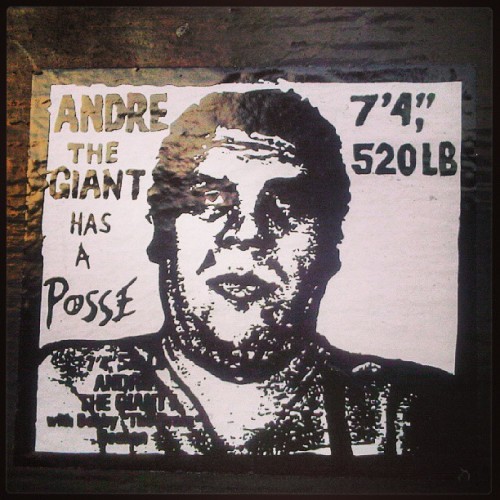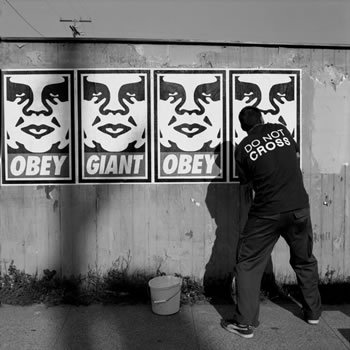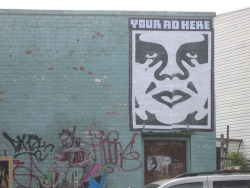At the crack of dawn on Halloween, balloons spelling “Banksy!” could be witnessed on the gray wall of an abandoned factory, rising above the relics left by other graffiti artists. The balloons represented the legacy of his work and influence on New Yorkers, and it was a silent farewell party for Banksy as he was to leave for the U.K. The large, bubble font letters could be spotted by drivers as they passed by on the Long Island Expressway. And of course, there were the fans that rushed to the scene as soon as the anonymous artist posted his work-of-the-day online.
The triumph was short-lived, however. Along with the fans was a less enthusiastic crowd. The New York Police Department followed Banksy’s updates on a marathon to capture the ghost-like artist and contain the influence of his work. The work he presented each day was always destroyed by the police or by other graffiti artists within hours of its release. As for the “Banksy!” balloons, the police confiscated them. Many other artists argued that the balloons could be valuable as an artwork: “They should give it to me and we’d sell it”, said Mr. Stephan Keszler, a New York gallery owner. However, the NYPD did not see Banksy’s work the same way. “I don’t have it as art on the invoice. We have it as a balloon”, said Deputy Chief Jack J. Trabitz. The city government described a similar take on Banksy’s work. Mayor Bloomberg stated that Banksy “is not my definition of art. I just think there are some places for art and there are some places [not for] art”.
A faceless British artist, Banksy settled in New York City for the month of October 2013. His objectives: to complete an “art residency”. At first glance this term could be mistaken as a strictly educational and peaceful study of art principles. On the contrary, Banksy turned the city upside down with his satirical illustrations of American society and politics. The NYPD went on a wild goose chase in order to arrest the rebellious artist. What did Banksy do wrong? Based on interviews with police, it was revealed that the city government did not perceive Banksy’s work as art. Rather, it believed that his work was a violation of other people’s property with no reasonable objectives.
The mixed responses to Banksy’s “products” led to several questions: Is graffiti considered art? Is Banksy’s work art? What were his intentions in conducting this project? Why did his work produce such a wide range of responses? According to an artist with the online name Wh Willy, not only is Banksy’s work an art, but his project brought the true meaning of art back to New York City: “Banksy is bringing art back to where it should be…the streets. Where people can interact with it in their daily life”. Wh Willy adds that, “the issue artists have with museums is it makes art very sterile – art has become so safe and boring that it’s having very little impact on society…We can’t stare at Picasso’s works forever…art needs to break out and become an important piece of our culture…” The title of Banksy’s residency, “Better Out Than In”, reinforces the comment made by Wh Willy. Art must break out of the social orders that are containing its true potentials
Similar to Wh Willy, many other artists expressed appreciation for Banksy’s project. Once an architecture and graphics design major in college, Ray Liao believes that Banksy’s work is beneficial to the community in several ways: “I think the owners of the properties where Banksy left his work were happy because they could make money from it being there”. Wh Willy added that instead of “being a bad influence” as the NYPD put it, Banksy had attracted children of all ages. Wh Willy believes that Banksy’s input on city walls could actually increase New York tourism and popularity. In addition, the “rebel” artist may just be the inspiration for young artists to explore the real world.
Mr. Liao and Wh Willy provided their insights to Banksy’s intentions, and they seem pretty fair. Now, the question to be answered is: did Banksy’s art violate New York City? “The idea of graffiti is to mark your territory and that’s where it separates from art”, states Mr. Liao, “but Banksy is not that type of graffiti artist. He did not just choose a random place and deface it. He actually selected where he thought his art would be interesting”. Mr. Liao described Banksy’s October 17 entry as an example. The artwork was produced on a wall in Williamsburg, Brooklyn. Banksy took advantage of a preexisting arch built into the wall by painting the silhouettes of two women in Japanese attire standing on the arch. Banksy creatively portrayed the arch as a bridge on which the two women were walking on. Unlike other graffiti, Banksy’s art was not an aggressive mark of territory. Instead, it was an artistic use of the characteristics of particular walls.
Banksy fans have supported his work by justifying his intentions, but he is still classified as a graffiti artist. Can graffiti be justified as an art then? Should it be legalized? These questions brought mixed replies. “Graffiti should be illegal in certain areas, but artists should have a place to represent themselves. They should not violate private property or public buildings, but I think all artists should have a canvas to express themselves,” said Mr. Liao. Many believe that graffiti is like the distant relative of mural painting. The problem with graffiti, however, is that it has strayed from its ultimate goals as an expressive art. Many graffiti artists of today use the art for gang representation and for visual violence. This interpretation of graffiti should be discouraged.
According to many artists including Banksy, the modern concept of art must be reformed in several ways. Territorial graffiti should be eliminated, while art should embody more than just museums – the indoors. Art is about diversity and innovation, but it involves nothing of violence. Even though most of Banksy’s art is considered graffiti, it was not produced for the purpose of debasing or dictating others. Banksy shedded a new light in which we should see art. We should not be confined to institutional art. Rather, we could explore new horizons to learn about it.
For the most part, Banksy’s art produced controversial reactions among New Yorkers because people were baffled by the nature of graffiti and how Banksy applied the art. He received opposition for the political and social criticism involved in his work. Many artists like Wh Willy and Mr. Liao encourage Banksy’s expressive methods, and they hope that artists to come will follow in his footsteps.
Works Cited
Banksy. Better Out Than In. Banksy, 1 Oct. 2013. Web. 5 Nov. 2013.
Buckley, Cara, and David J. Goodman. “Police Confiscate Banksy Balloons and Say
They’re Not Art.” The New York Times. The New York Times, 5 Nov. 2013.
Web. 7 Nov. 2013.
Cush, Andy. “Mayor Bloomberg Disapproves of Banksy.” Animal. Animal, 16 Oct. 2013.
Web. 7 Nov. 2013.
Liao, Ray. “Banksy & Graffiti.” Personal interview. 17 Nov. 2013.
Smith, Roberta. “Mystery Man, Painting the Town: Banksy Makes New York His
Gallery for a Month.” The New York Times. The New York Times, 30 Oct. 2013.
Web. 5 Nov. 2013.
Wh Willy. “Re: Banksy Made News, but Not a Lot of Great Art.” Web log comment.
New York Post. New York Post, 15 Nov. 2013. Web. 19 Nov. 2013.
Zeaman, John. “Banksy Made News, but Not a Lot of Great Art.” New York Post. New
York Post, 2 Nov. 2013. Web. 7 Nov. 2013.





